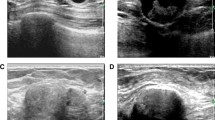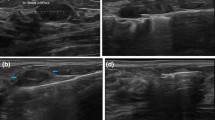Abstract
Background
Gynecomastia is the most common benign disease in males with an increasing prevalence in recent years. It may cause local pain and psychological disorders. The vacuum-assisted breast biopsy system has been reported to be a novel surgical approach for the treatment of gynecomastia. However, there are little detailed reports comparing the curative effect between traditional surgery and vacuum-assisted breast biopsy for gynecomastia. Besides, there was little study which compared the application of two different systems for the treatment of gynecomastia. Our study aimed to investigate the effectiveness of vacuum-assisted breast biopsy systems for patients with gynecomastia.
Methods
We retrospectively reviewed 83 patients with gynecomastia between January 2015 and December 2019. Open surgery was performed in 56 patients, and vacuum-assisted breast biopsy was performed in 27 patients. The characteristics of patients as well as the curative effects between the two groups were analyzed. The two vacuum-assisted breast biopsy systems (Mammotome and Encor) were performed for the patients with gynecomastia. The efficacy, safety, complications, and patient satisfactions were recorded during postoperative follow-up periods.
Results
Compared with the open surgery group, the vacuum-assisted breast biopsy group had significantly smaller scar sizes left after the operation (5.5 ± 1.3 cm vs 0.8 ± 0.2 cm, p < 0.001), and shorter hospital stay time (5.5 ± 2.4 ds vs 3.1 ± 1.6 ds, p < 0.001). Patients in vacuum-assisted breast biopsy group had a better cosmetic outcome than those in open surgery group. There were no statistically significant differences between the two vacuum-assisted breast biopsy systems according to the mean age, the mean operation time, sites, or grade. In addition, no serious complications were observed in vacuum-assisted breast biopsy group. All the patients recovered well and were satisfied with the cosmetic outcomes.
Conclusion
The vacuum-assisted breast biopsy system can be used as a feasible and minimally invasive approach for the treatment of gynecomastia.
Level of Evidence IV
This journal requires that authors assign a level of evidence to each article. For a full description of these Evidence-Based Medicine ratings, please refer to the Table of Contents or the online Instructions to Authors www.springer.com/00266.

Similar content being viewed by others
References
Narula HS, Carlson HE (2014) Gynaecomastia–pathophysiology, diagnosis and treatment. Nat Rev Endocrinol 10:684–698
Braunstein GD (2007) Clinical practice. Gynecomastia. N Engl J Med 357:1229–1237
Nuttall FQ, Warrier RS, Gannon MC (2015) Gynecomastia and drugs: a critical evaluation of the literature. Eur J Clin Pharmacol 71:569–578
Olsson H, Bladstrom A, Alm P (2002) Male gynecomastia and risk for malignant tumours–a cohort study. BMC Cancer 2:26
Rew L, Young C, Harrison T, Caridi R (2015) A systematic review of literature on psychosocial aspects of gynecomastia in adolescents and young men. J Adolesc 43:206–212
Hanavadi S, Banerjee D, Monypenny IJ, Mansel RE (2006) The role of tamoxifen in the management of gynaecomastia. Breast 15:276–280
Ladizinski B, Lee KC, Nutan FN, Higgins HW 2nd, Federman DG (2014) Gynecomastia: etiologies, clinical presentations, diagnosis, and management. South Med J 107:44–49
Webster DJ (1989) Benign disorders of the male breast. World J Surg 13:726–730
Simon BE, Hoffman S, Kahn S (1973) Classification and surgical correction of gynecomastia. Plast Reconstr Surg 51:48–52
Abdelrahman I, Steinvall I, Mossaad B, Sjoberg F, Elmasry M (2018) Evaluation of glandular liposculpture as a single treatment for grades I and II gynaecomastia. Aesthet Plast Surg 42:1222–1230
Waltho D, Hatchell A, Thoma A (2017) Gynecomastia classification for surgical management: a systematic review and novel classification system. Plast Reconstr Surg 139:638e–648e
Soliman AT, De Sanctis V, Yassin M (2017) Management of adolescent gynecomastia: an update. Acta Biomed 88:204–213
Qutob O, Elahi B, Garimella V, Ihsan N, Drew PJ (2010) Minimally invasive excision of gynaecomastia–a novel and effective surgical technique. Ann R Coll Surg Engl 92:198–200
Varlet F, Raia-Barjat T, Bustangi N, Vermersch S, Scalabre A (2019) Treatment of gynecomastia by endoscopic subcutaneous mastectomy in adolescents. J Laparoendosc Adv Surg Tech A 29:1073–1076
Brown RH, Chang DK, Siy R, Friedman J (2015) Trends in the surgical correction of gynecomastia. Semin Plast Surg 29:122–130
Cao H, Yang ZX, Sun YH, Wu HR, Jiang GQ (2013) Endoscopic subcutaneous mastectomy: a novel and effective treatment for gynecomastia. Exp Ther Med 5:1683–1686
Mariscotti G, Durando M, Robella M, Angelino F, Regini E, Campanino PP, Belletti M, Osano S, Bergamasco L, Fonio P, Gandini G (2015) Mammotome((R)) and EnCor ((R)): comparison of two systems for stereotactic vacuum-assisted core biopsy in the characterisation of suspicious mammographic microcalcifications alone. Radiol Med 120:369–376
Park HL, Hong J (2014) Vacuum-assisted breast biopsy for breast cancer. Gland Surg 3:120–127
Iwuagwu OC, Calvey TA, Ilsley D, Drew PJ (2004) Ultrasound guided minimally invasive breast surgery (UMIBS): a superior technique for gynecomastia. Ann Plast Surg 52:131–133
Wang Y, Wang J, Liu L, Liang W, Qin Y, Zheng Z, Zou S, Xu Y, Chen C, Feng Z, Zhang J, Tao L, Chen X (2019) Comparison of curative effects between mammotome-assisted minimally invasive resection (MAMIR) and traditional open surgery for gynecomastia in Chinese patients: a prospective clinical study. Breast J 25:1084–1089
Yao Y, Yang Y, Liu J, Wang Y, Zhao Y (2019) Vacuum-assisted minimally invasive surgery—an innovative method for the operative treatment of gynecomastia. Surgery 166:934–939
Bailey SH, Guenther D, Constantine F, Rohrich RJ (2016) Gynecomastia management: an evolution and refinement in technique at UT southwestern medical center. Plast Reconstr Surg Glob Open 4:e734
Wyrick DL, Roberts M, Young ZT, Mancino AT (2018) Changing practices: the addition of a novel surgical approach to gynecomastia. Am J Surg 216:547–550
Longheu A, Medas F, Corrias F, Farris S, Tatti A, Pisano G, Erdas E, Calo PG (2016) Surgical management of gynecomastia: experience of a general surgery center. G Chir 37:150–154
Kim DH, Byun IH, Lee WJ, Rah DK, Kim JY, Lee DW (2016) Surgical management of gynecomastia: subcutaneous mastectomy and liposuction. Aesthet Plast Surg 40:877–884
Fricke A, Lehner GM, Stark GB, Penna V (2017) Long-term follow-up of recurrence and patient satisfaction after surgical treatment of gynecomastia. Aesthet Plast Surg 41:491–498
Park HL, Kim LS (2011) The current role of vacuum assisted breast biopsy system in breast disease. J Breast Cancer 14:1–7
Wang ZL, Liu G, Huang Y, Wan WB, Li JL (2012) Percutaneous excisional biopsy of clinically benign breast lesions with vacuum-assisted system: comparison of three devices. Eur J Radiol 81:725–730
Acknowledgements
We are especially grateful to all the patients that participated in this study. This work was supported by Grants from the Natural Science Foundation of China (81702598, 81602328, U1601223), the Science Foundation of Guangdong Province (2017A030313803, 2016A030310175, 2016A030313312), and the Science and Technology Program of Guangzhou (201804010011, 201704020131), the China Postdoctoral Science Foundation (2015M582471), the Medical Scientific Research Foundation of Guangdong Province of China (A2017235).
Author information
Authors and Affiliations
Contributions
All authors performed study design, data collection, data analysis, and writing.
Corresponding author
Ethics declarations
Conflict of interest
The authors declare that they have no conflict of interest.
Ethical Approval
This study was approved by the ethics review board of the first affiliated hospital of Jinan University.
Informed Consent
Written informed consent was obtained from all patients.
Additional information
Publisher's Note
Springer Nature remains neutral with regard to jurisdictional claims in published maps and institutional affiliations.
Rights and permissions
About this article
Cite this article
Qu, S., Zhang, W., Li, S. et al. The Vacuum-Assisted Breast Biopsy System is an Effective Strategy for the Treatment of Gynecomastia. Aesth Plast Surg 45, 404–410 (2021). https://doi.org/10.1007/s00266-020-01931-8
Received:
Accepted:
Published:
Issue Date:
DOI: https://doi.org/10.1007/s00266-020-01931-8




